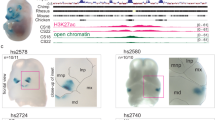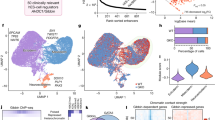Abstract
Transcription factor paralogs may share a common role in staged or overlapping expression in specific tissues, as in the Hox family. In other cases, family members have distinct roles in a range of embryologic, differentiation or response pathways (as in the Tbx and Pax families). For the interferon regulatory factor (IRF) family of transcription factors, mice deficient in Irf1, Irf2, Irf3, Irf4, Irf5, Irf7, Irf8 or Irf9 have defects in the immune response but show no embryologic abnormalities1,2,3,4,5,6,7. Mice deficient for Irf6 have not been reported, but in humans, mutations in IRF6 cause two mendelian orofacial clefting syndromes8,9,10, and genetic variation in IRF6 confers risk for isolated cleft lip and palate11,12,13,14,15. Here we report that mice deficient for Irf6 have abnormal skin, limb and craniofacial development. Histological and gene expression analyses indicate that the primary defect is in keratinocyte differentiation and proliferation. This study describes a new role for an IRF family member in epidermal development.
This is a preview of subscription content, access via your institution
Access options
Subscribe to this journal
Receive 12 print issues and online access
$209.00 per year
only $17.42 per issue
Buy this article
- Purchase on Springer Link
- Instant access to full article PDF
Prices may be subject to local taxes which are calculated during checkout





Similar content being viewed by others
References
Matsuyama, T. et al. Targeted disruption of IRF-1 or IRF-2 results in abnormal type I IFN gene induction and aberrant lymphocyte development. Cell 75, 83–97 (1993).
Sato, M. et al. Distinct and essential roles of transcription factors IRF-3 and IRF-7 in response to viruses for IFN-alpha/beta gene induction. Immunity 13, 539–548 (2000).
Mittrucker, H.W. et al. Requirement for the transcription factor LSIRF/IRF4 for mature B and T lymphocyte function. Science 275, 540–543 (1997).
Takaoka, A. et al. Integral role of IRF-5 in the gene induction programme activated by Toll-like receptors. Nature 434, 243–249 (2005).
Honda, K. et al. IRF-7 is the master regulator of type-I interferon-dependent immune responses. Nature 434, 772–777 (2005).
Holtschke, T. et al. Immunodeficiency and chronic myelogenous leukemia-like syndrome in mice with a targeted mutation of the ICSBP gene. Cell 87, 307–317 (1996).
Kimura, T. et al. Essential and non-redundant roles of p48 (ISGF3 gamma) and IRF-1 in both type I and type II interferon responses, as revealed by gene targeting studies. Genes Cells 1, 115–124 (1996).
Kondo, S. et al. Mutations in IRF6 cause Van der Woude and popliteal pterygium syndromes. Nat. Genet. 32, 285–289 (2002).
Kayano, S. et al. Novel IRF6 mutations in Japanese patients with Van der Woude syndrome: two missense mutations (R45Q and P396S) and a 17-kb deletion. J. Hum. Genet. 48, 622–628 (2003).
Wang, X. et al. Novel mutations in the IRF6 gene for Van der Woude syndrome. Hum. Genet. 113, 382–386 (2003).
Zucchero, T.M. et al. Interferon regulatory factor 6 (IRF6) gene variants and the risk of isolated cleft lip or palate. N. Engl. J. Med. 351, 769–780 (2004).
Blanton, S.H. et al. Variation in IRF6 contributes to nonsyndromic cleft lip and palate. Am. J. Med. Genet. A 137, 259–262 (2005).
Ghassibe, M. et al. Interferon regulatory factor-6: a gene predisposing to isolated cleft lip with or without cleft palate in the Belgian population. Eur. J. Hum. Genet. 13, 1239–1242 (2005).
Scapoli, L. et al. Strong evidence of linkage disequilibrium between polymorphisms at the IRF6 locus and nonsyndromic cleft lip with or without cleft palate, in an Italian population. Am. J. Hum. Genet. 76, 180–183 (2005).
Srichomthong, C., Siriwan, P. & Shotelersuk, V. Significant association between IRF6 820G->A and non-syndromic cleft lip with or without cleft palate in the Thai population. J. Med. Genet. 42, e46 (2005).
Zambrowicz, B.P. et al. Disruption and sequence identification of 2,000 genes in mouse embryonic stem cells. Nature 392, 608–611 (1998).
Bailey, C.M. et al. Mammary serine protease inhibitor (Maspin) binds directly to interferon regulatory factor 6: identification of a novel serpin partnership. J. Biol. Chem. 280, 34210–34217 (2005).
Knight, A.S., Schutte, B.C., Jiang, R. & Dixon, M.J. Developmental expression analysis of the mouse and chick orthologues of IRF6: the gene mutated in Van der Woude syndrome. Dev. Dyn. 235, 1441–1447 (2006).
Hu, Y. et al. Abnormal morphogenesis but intact IKK activation in mice lacking the IKKalpha subunit of IkappaB kinase. Science 284, 316–320 (1999).
Sil, A.K., Maeda, S., Sano, Y., Roop, D.R. & Karin, M. IkappaB kinase-alpha acts in the epidermis to control skeletal and craniofacial morphogenesis. Nature 428, 660–664 (2004).
Benitah, S.A., Frye, M., Glogauer, M. & Watt, F.M. Stem cell depletion through epidermal deletion of Rac1. Science 309, 933–935 (2005).
Richardson, R.J. et al. IRF6 is a key determinant of the keratinocyte proliferation-differentiation switch. Nat. Genet. advance online publication 15 October 2006 (doi:10.1038/ng1894).
Fisher, C., Jones, A. & Roop, D.R. Abnormal expression and processing of keratins in pupoid fetus (pf/pf) and repeated epilation (Er/Er) mutant mice. J. Cell Biol. 105, 1807–1819 (1987).
Herron, B.J. et al. A mutation in stratifin is responsible for the repeated epilation (Er) phenotype in mice. Nat. Genet. 37, 1210–1212 (2005).
Li, Q., Lu, Q., Estepa, G. & Verma, I.M. Identification of 14–3-3sigma mutation causing cutaneous abnormality in repeated-epilation mutant mouse. Proc. Natl. Acad. Sci. USA 102, 15977–15982 (2005).
Sugihara, T.M., Kudryavtseva, E.I., Kumar, V., Horridge, J.J. & Andersen, B. The POU domain factor Skin-1a represses the keratin 14 promoter independent of DNA binding. A possible role for interactions between Skn-1a and CREB-binding protein/p300. J. Biol. Chem. 276, 33036–33044 (2001).
Dornan, D. et al. Interferon regulatory factor 1 binding to p300 stimulates DNA-dependent acetylation of p53. Mol. Cell. Biol. 24, 10083–10098 (2004).
Qin, B.Y. et al. Crystal structure of IRF-3 in complex with CBP. Structure 13, 1269–1277 (2005).
Yang, H., Lin, C.H., Ma, G., Baffi, M.O. & Wathelet, M.G. Interferon regulatory factor-7 synergizes with other transcription factors through multiple interactions with p300/CBP coactivators. J. Biol. Chem. 278, 15495–15504 (2003).
MacPartlin, M. et al. p300 regulates p63 transcriptional activity. J. Biol. Chem. 280, 30604–30610 (2005).
Acknowledgements
The authors wish to acknowledge technical assistance from E. Sweezer, R. Cao, T. Kinney, S. Bullard, H. Mishima and A. Lidral. We also thank K. Walters and J. Shao of the Central Microscopy Research Facility and K. Knudtson of the DNA Core Facility at the University of Iowa. We wish to thank R. Richardson and M. Dixon for sharing results before publication. This work was supported in part by US National Institutes of Health grants DE16215 (J.C.M., B.C.S., M.L., B.Y.), DE13513 (B.C.S.) and DE08559 (J.C.M.).
Author information
Authors and Affiliations
Contributions
This study was designed by B.C.S., S.K., J.C.M. and B.Y.; phenotype assessment was performed by C.R.I., A.K., K.J.T., M.D. and S.L.G.; genotype assessment was performed by M.I.M. and A.K.; data analysis was performed by S.S. and M.L.; and C.R.I., B.C.S., J.C.M., M.L., A.K. and M.D. contributed to the writing of the paper.
Corresponding author
Ethics declarations
Competing interests
The authors declare no competing financial interests.
Supplementary information
Supplementary Table 1
Change in gene expression for epidermal differentiation markers in Irf6 wild-type versus null skin. (PDF 55 kb)
Supplementary Table 2
Sequence of PCR primers for genotyping Irf6 gene trap allele. (PDF 38 kb)
Rights and permissions
About this article
Cite this article
Ingraham, C., Kinoshita, A., Kondo, S. et al. Abnormal skin, limb and craniofacial morphogenesis in mice deficient for interferon regulatory factor 6 (Irf6). Nat Genet 38, 1335–1340 (2006). https://doi.org/10.1038/ng1903
Received:
Accepted:
Published:
Issue Date:
DOI: https://doi.org/10.1038/ng1903
This article is cited by
-
Functions of the RIP kinase family members in the skin
Cellular and Molecular Life Sciences (2023)
-
Negative regulation of interferon regulatory factor 6 (IRF6) in interferon and NF-κB signalling pathways of common carp (Cyprinus carpio L.)
BMC Veterinary Research (2022)
-
FACEts of mechanical regulation in the morphogenesis of craniofacial structures
International Journal of Oral Science (2021)
-
Deducing signaling pathways from parallel actions of arsenite and antimonite in human epidermal keratinocytes
Scientific Reports (2020)
-
The RIPK4–IRF6 signalling axis safeguards epidermal differentiation and barrier function
Nature (2019)



